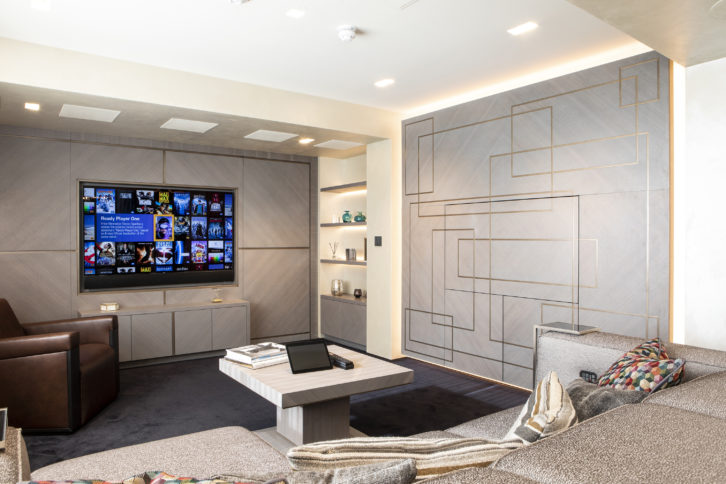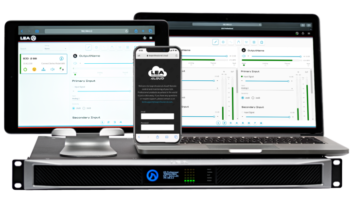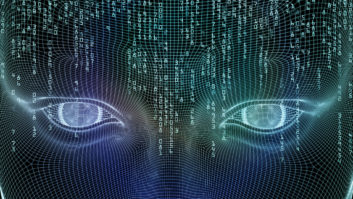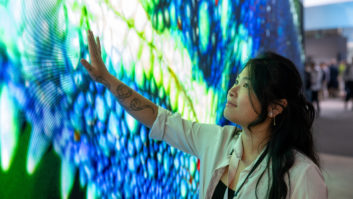“We’re seeing a lot of growth and a huge appetite for what the CEDIA channel can deliver,” smiles Homeplay MD, James Ratcliffe. “Lighting and shading is a key area for us, as well as making technology invisible – plaster-in speakers, temperature sensors, light fittings, keypads, ventilation grilles, blind pockets, mains sockets – you name it. The more tech that CEDIA members can make disappear, the better it is for everyone.”
Sean Miller aligns himself with both (Steve) Detmer and Ratcliffe. “Two things plummeting in popularity are wires and devices,” he says. “Today, consumers demand products that are easy to install, use and customise. Wireless technology has become ubiquitous across the smart market and will creep into more and more technologies.”
“The second trend to disappear is multiple management devices,” he goes on. “Technology used to be siloed and thus have specialised touch points. Today, most smart home solutions are wireless, controllable through a mobile application.”
“In terms of specific equipment,” he adds, “we see continued growth within wireless security systems whether they be alarms, CCTV or doorbells – and now we see physical door locks entering the market.”

Ratcliffe also notes that his company Homeplay is seeing much less demand for TVs – and more demand for larger, higher quality screens. “Ten years ago,” he continues, “we were installing TVs in every bedroom – often upwards of 10 TVs in a project. Now, even in a very large house, it’s not uncommon to only have three TVs – but they’re bigger, better, and augmented by great sound systems.”
Unobtrusive
And, according to Koen Dekyvere of home automation company Basalte: if you can’t make the technology disappear, the next best thing is to make it unobtrusive. “We’re seeing far more acceptance of iPads and smaller touchscreens in today’s luxury interiors,” he says. “It’s all about reducing wall clutter. Our Ellie touch panel for Basalte Home is an elegant, small yet very multifunctional touchscreen. It eliminates the need for having numerous buttons, indoor doorcom stations and thermostats on the wall, as it’s all combined in this multifunctional device, with no clutter.”
Today, it’s clear that consumers are in love with voice as a way of interacting with their smart home devices. The novelty of asking Alexa to turn off the lounge lights still hasn’t worn off. But: if voice is the present – is it also the future?
“I’m not even convinced voice control is the present,” laughs Ratcliffe. “It’s not reliable or smart enough as it stands. Although companies like Josh.ai are making big steps forward, in my experience it’s just too flaky to be anything more than a toy or something to show off with. It will get better, and in a few years’ time I can see it becoming a key UI – but for the foreseeable future, I don’t think you can beat a thoughtfully engraved keypad or well-designed touch panel.”
Others, however, are less certain that voice has much of a future as AI becomes increasingly embedded in how we do things – not least in our homes.
- Residential systems special report: Part one
- Showcase: Lighting control
- Technology takes you home smart home: ISE Daily
Machine learning
“Voice control will become less of a necessity in the future smart home,” believes SnapAV’s Kindel. “In the future smart home, the platform will manage all connected devices within the home by using machine learning algorithms to provide intelligent recommendations and take action to streamline the home experience. The home’s predictive automation can take a wide range of actions based on an understanding of daily routines such as waking up, leaving, returning home, and going to bed. For example, the home will begin to recognise the family’s bedtime routine and develop a scene to automatically manage temperature, lighting, audio, and security settings based on learned preferences. The home will be able to analyse the data in the home just as a human would analyse the situation before making a decision, freeing up the homeowner from having to maintain the home routine and simplifying their daily task management. Tech companies are trying to get there, but there is still a lot of work to be done.”
Detmer is in agreement. “Smart homes will continue to get smarter. Through enhanced algorithms, home automation will become autonomous, making informed decisions on behalf of the homeowner. Occupancy sensors may suggest a resident has left their home, triggering HVAC to reduce and lights to turn off. These systems will self-optimise, to create the most comfortable, convenient and energy efficient homes.”
TIG’s Pini sees things the same way. “I think voice control has seen its heyday,” he declares, “but it has really helped to introduce home automation to the wider market. The next big thing is undoubtedly AI. I envisage a world where the home control system will learn our habits – it will turn your lights off when you’re sat on the sofa, it will turn the extractor fan on when you start cooking, it will select the TV channel you want to watch… It will be less about gesture and physical touch control, and more about learning patterns until, ultimately, a home is more aware of your daily routine than you are.”
Bright future
For this brave new world to become a reality, however, assumes two things. The first is a higher degree of interoperability than is commonly the case today – and the second, even greater network capacity.
On the latter point, AirTies’ Yildirim sees a bright future. “IoT in the residential market is still at an early stage,” he says. “In the coming years, more devices and home appliances will rely on Internet connectivity. To support this trend, one of the newest innovations is occurring in WiFi, with the introduction of WiFi 6. In addition to increased speed and capacity, WiFi 6 products will be designed to support the growing density of connected devices within the home, delivering lower latency, enhanced battery life to IoT devices and reduced interference from neighbouring WiFi networks. To date, there are a limited number of new products using WiFi 6, but in the coming years, it will accelerate dramatically.”
And interoperability? There’s widespread agreement that we’re not yet where we need to be – although huge strides have been made. “Interoperability among smart home products has evolved significantly over the last five years,” notes Kindel. “The presence of a robust and reliable smart home operating system, like Control4 OS 3, significantly boosts the interoperability between products within a home. OS 3 manages nearly 14,000 devices from hundreds of third-party manufacturers.”
Ecosystems
“Z-Wave is one of the largest interoperable smart home ecosystems on the market today,” points out Klein, “with over 3,200 certified and interoperable products – and Z-Wave can be found in more than 90% of the home security market. We’ve also taken recent steps to ensure that interoperability continues to be a priority for the smart home: in December 2019, we announced along with Z-Wave silicon provider, Silicon Labs, that we are opening the Z-Wave network layer and communication protocol for the Z-Wave specification, making it available to new kinds of vendors like the semiconductor and software supplier community.”
Basalte too sees the benefit of industry standards in facilitating interoperability. “Our solutions and products are designed and built for larger residential projects,” explains Dekyvere, “founded on a separate home automation network using the KNX standard and an integrated but dedicated audio network for streaming music over the network.”
This approach, he points out, also means that impact on the standard home network is minimised. Dekyvere also stresses the effort Basalte puts into ensuring the seamless integration of third party offerings. “If we’re including new devices in our programming software, it means we’ve thoroughly tested them and we’ve done everything to ensure the solution will work flawlessly and for the long run,” he notes.
Evolution
There is, then, much agreement among the industry that the growth in smart homes is being driven by devices that might otherwise have been seen as a threat. What consumers want from their smart homes is evolving. Many see voice as a short-term fad that will ultimately be replaced by truly smart, AI-based systems that will know what we want before we know it ourselves. Similarly, there is acceptance that, as far as we may have come in terms of interoperability, there is still a distance to travel – but, as with network bandwidth, we’ll soon have what we need. Not least, there is agreement that, to make the smart homes of the future a reality, there will be a vital role for skilled integrators.
Now, if those integrators can just persuade us to stop asking Alexa “Alexa: what’s my wife’s name?” for the simple, childish amusement of hearing her respond “If you don’t know, I think you’re in trouble – or you might be soon…”







